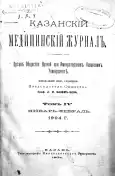Vol 4, No 1-2 (1904)
- Year: 1904
- Published: 10.01.1904
- Articles: 14
- URL: https://kazanmedjournal.ru/kazanmedj/issue/view/2875
Full Issue
Radium in biology and medicine
Abstract
Not a single discovery in the field of science and art, no matter how small, never remains without influence on other departments of human knowledge. Light, even the weakest, introduced into one area of our knowledge, should, as a rule, illuminate other departments to a greater or lesser extent. Without a doubt, the intensity and area of illumination will be the stronger and more, the stronger the new light source, the wider it scatters its rays.
 1-19
1-19


Towards the doctrine of acute leukemia
Abstract
Fränkel at the XV Congress of Internal Medicine deals with the clinical side of the process, the properties of blood, and also brings a new case of acute leukemia. The most important clinical signs of acute leukemia, in addition to its rapid course, Fränkel considers: the early appearance of hemorrhagic diathesis, enlargement of the lymphatic glands, especially the cervical, and sometimes the whole body, more or less severe swelling of the spleen, and also in most cases of the liver. In half of the cases F. observed an increased temperature and an increasing, with blood loss, pallor.
 20-78
20-78


Bacteriological study of the water supply system of Kazan
Abstract
Bacteriological control of tap water is carried out strictly in Western Europe wherever there is a hygienic station. I observed such control in the city of Breslavl (in Silesia), where I worked in the hygienic institute with Professor Flügge, from October 1900 to February 1901. Professor Flügge himself performs bacteriological control of tap water in the city of Breslavl.
 79-84
79-84


Description of the device of clinics, city hospitals and some public institutions and special institutions in Germany (in Prussia, Saxony, Bavaria and Silesia) and in Paris
Abstract
As a hygienist, I describe the above-mentioned institutions only from this side. During my business trip to Germany and France, I originally arrived in Berlin, which is why I will start from this point. Berlin's most famous medical school is the Charité. This is an ancient type of a huge three-story building with a very gloomy appearance from the outside.
 85-103
85-103


М. Beloglazov. On the hematology of scurvy. Vrach. Gaz., 1903, Nos. 44-47
Abstract
11 people of scurvy patients of various ages (from 14 to 52 years old) were investigated by the author from the side of blood changes. The main results of the study are as follows: i) The absolute amount of hemoglobin in all the cases studied is reduced; the gradual increase during recovery does not reach the norm even when the number of red blood cells becomes normal.
 104-105
104-105


N.Y. Chistovich and O.A. Shestakova. On morphological changes in the blood in rubella. Vrach. Gaz., 1904, No. 1
Abstract
On the basis of 4 investigated hematologically patients (children 7-10 years old), the authors come to the next conclusions. By comparison with the data of normal blood composition, it turns out that the total number of white blood cells, corpuscles in patients with rubella is in the norm (out of three increased in one to 13876-21503; norm 3900-11352).
 105-106
105-106


R. D. Zelensky. To the casuistry of echinococcus of the brain. Vrach. Gaz., 1904, No. 1
Abstract
On the dissection of the brain of a patient who died with an unclear diagnosis, it was found that from the lower horn of the right lateral ventricle, stretching it and adjoining the ependymus with its shell, a tumor emanates, which, with projection on the surface, occupies the area of the anterior central crown of the gyrus, the entire part of the temporal.
 106-106
106-106


 106-107
106-107


V. N. Rozanov. On the operative technique in vertebral diseases. Surgery, Volume XIV, No. 83
Abstract
In several cases, the author had to access the anterior surface of various parts of the spine. In one case, where the caries of the right transverse process of the II cervical vertebra were diagnosed, the author used Chiene's method, which included an incision along the posterior edge of m. sternocleidomasto dei and penetration deep behind the large vessels, while the long cervical muscle lying directly above the anterior surface of the spine moves back together with the sympathetic nerve.
 107-107
107-107


V. N. Orlov. Modern classification of acute intestinal obstruction; mesenteric orifices as a cause of intestinal obstruction. Surgery, Volume XIV, No. 83
Abstract
Historical review of literary data to lead to the following classification of intestinal obstruction. There are two groups of pains - dynamic obstruction (without anatomical reasons) and mechanical. The first is divided into two subgroups — paralytic and spastic obstruction.
 107-108
107-108


G. I. Volntsev. On methods of reaching the nasopharyngeal space by rhinotomy and resections. A new method of access to the nasopharynx. Surgery, Volume XIV, No. 84
Abstract
When classifying the methods for reaching the nasopharynx, the author in the 1st group includes those in which the nasal segment of the upper jaw is not damaged; such are the methods of Rouge, B a r a c z'a, Cast ex, etc. Their common merit is in the slight disfigurement of the face, general, the most important disadvantage is in the small opening of the nasopharynx. The second group - methods of partial displacement of the nose with damage to the nasal process of the upper jaw.
 108-109
108-109


 109-110
109-110


А. A. Abrazhanov. Gastroenterostomy in benign gastric distresses. Surgery, vol. XIV, Nо. 84
Abstract
The main and most frequent benign stomach disease is a round ulcer with its complications. This disease, which affects (according to German statistics) 4-5% of the population and which spontaneously heals only in 0.75%, gives an average mortality rate of 25-30%.
 110-111
110-111


 112-119
112-119











